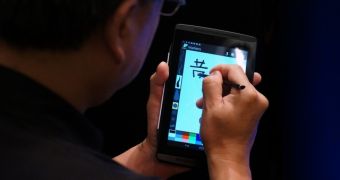With Samsung, Qualcomm and even Intel winning tablet and phone design wins, Tegra 4 is proving to be less adept at enchanting makers of slates than Tegra 3. Which is why NVIDIA is doing all it can to increase its appeal. So, since the great CPU and GPU performance have already been established, the company's CEO decided to show something else at Computex 2013.
Computex is currently taking place in Taipei, Taiwan (June 4 – June 8, 2013).
There, Nvidia CEO Jen-Hsun Huang demonstrated stylus support on a reference Tegra 4 tablet, a particularly small one actually.
NVIDIA thought that any device manufacturer could find use for a technology that allows any stylus to be employed for “calligraphy on a tablet” as Huang called it.
Normally, in order for a slate to detect pressure changes, especially fine gradations in pressure, an active stylus is required.
In the demo, though, as reported by The Verge, a normal tablet used a normal touchscreen and a regular stylus to achieve that (a crude conductive stylus to be specific).
Huang calls the technology DirectTouch, and this is the third rendition.
"The precision of DirectTouch is many, many times higher than your normal touch controller," said the CEO, "the resolution and sample rate are much higher."
The new technology may end up being called something other than DirectTouch when it starts being integrated in Tegra 4 tablets.
Choosing it should save companies, and customers, $20 / €15 – 20 per unit. That's what it would normally take to buy an active stylus on top of everything.
In the current climate, customers from the business sector are most likely to respond to this marketing tactic. Of course, no one will be stopping regular consumers from buying one of these DirectTouch-enabled tablets. Or whatever the technology ends up being called.

 14 DAY TRIAL //
14 DAY TRIAL //